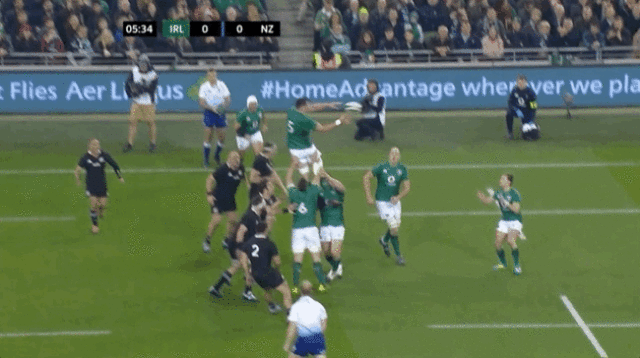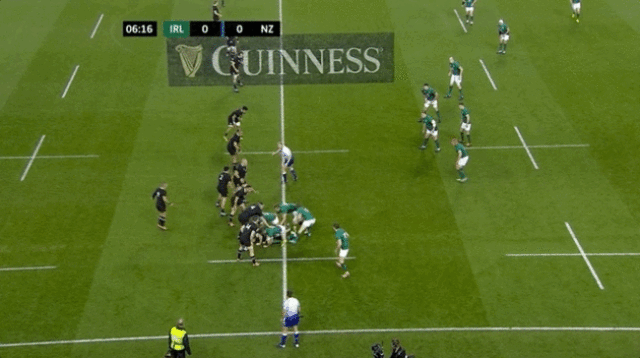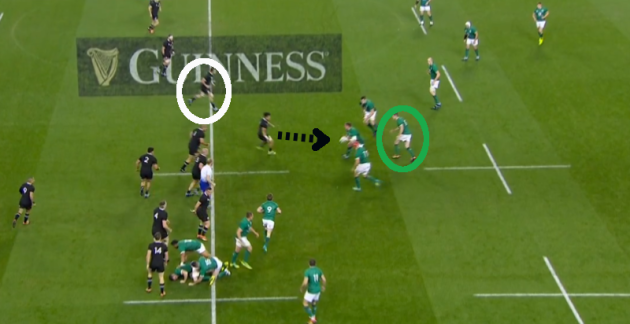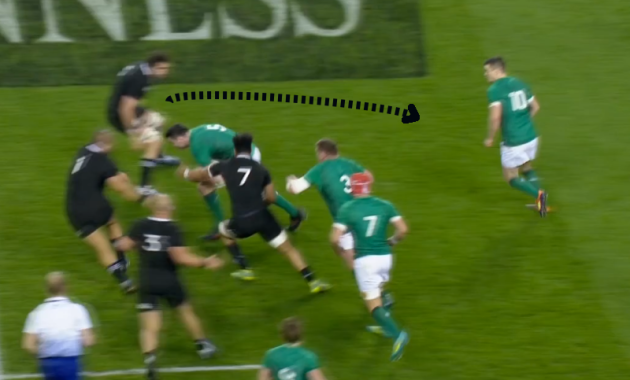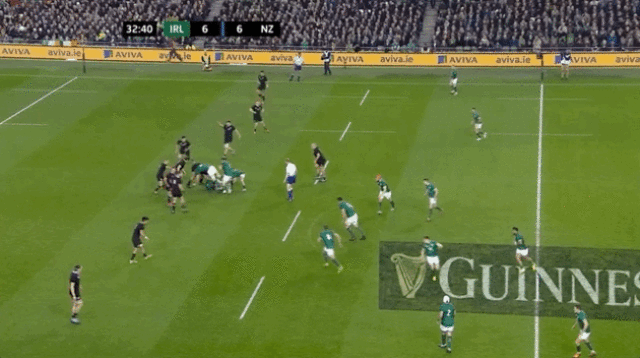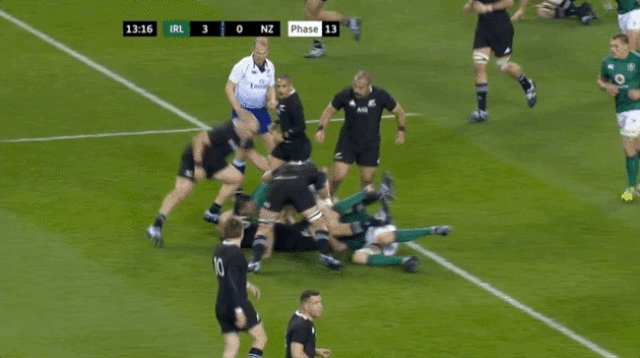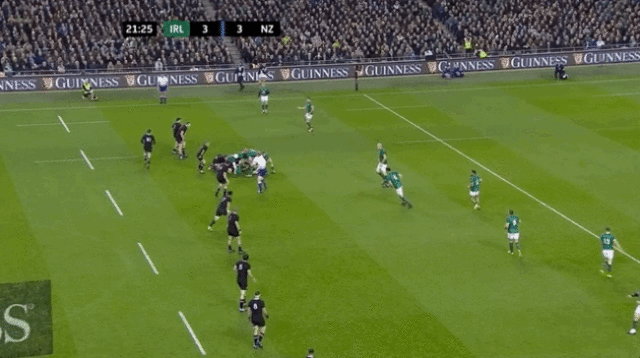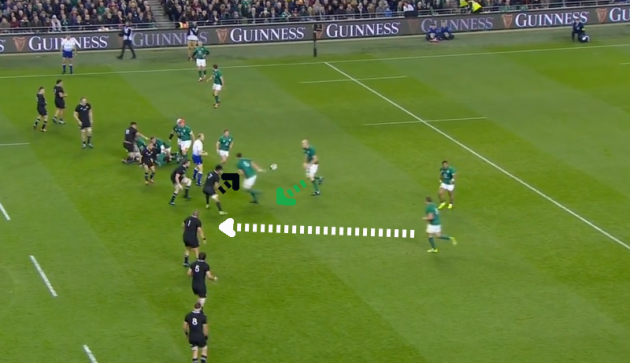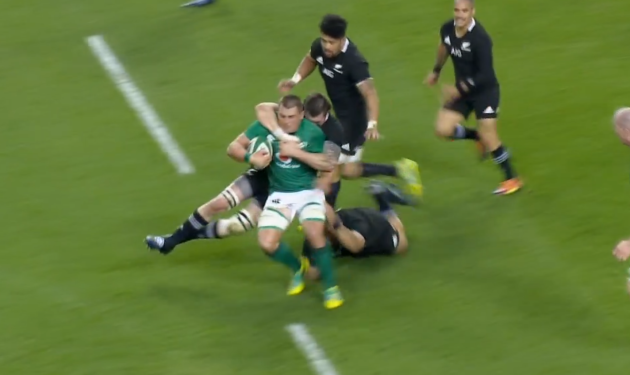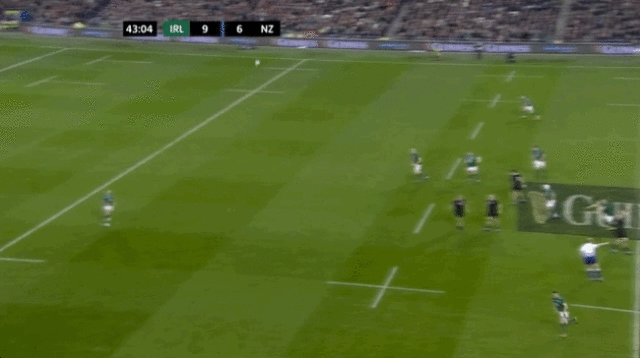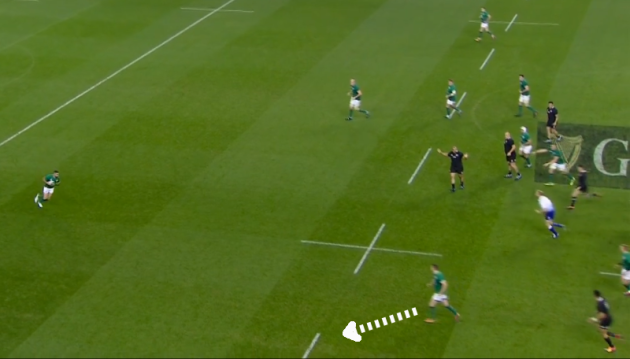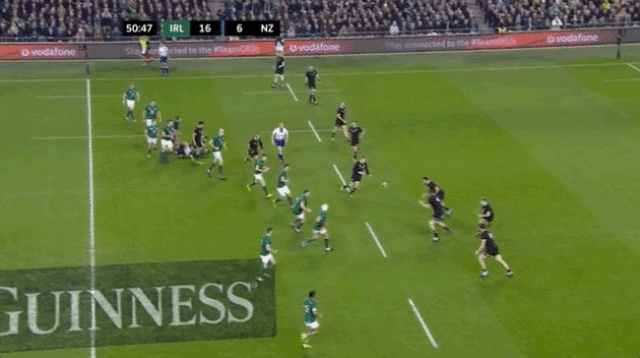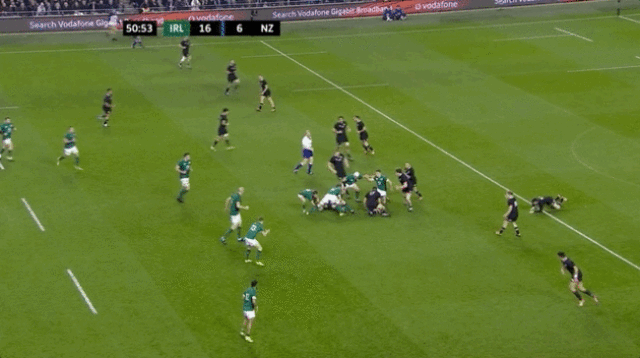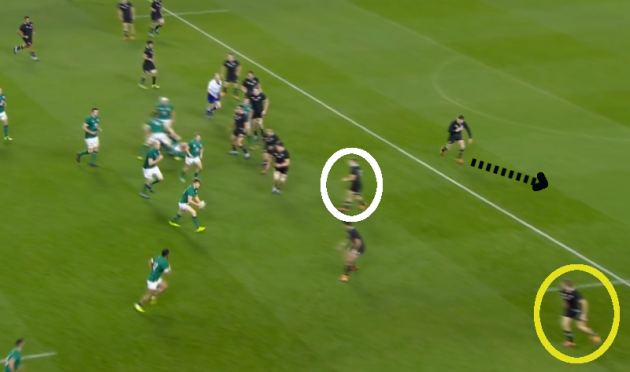SATURDAY NIGHT IN Dublin provided us with one hell of a Test match, in more ways than one.
There was, simply put, a huge amount of Test rugby involved, with the ball-in-play time hitting 45 minutes and five seconds.
45:05 might not seem like much when a game is supposed to be 80 minutes long, but that figure is lung-burstingly high.
Ball-in-play times have been rising in rugby for some years now, but the average in the 2017 Six Nations report was 39:17.
The high figure from Ireland’s win over the All Blacks on Saturday underlines how much both sets of players put into the contest, one that Joe Schmidt’s side deservedly won.
Ireland’s defence – all 188 completed tackles of it – was superb and defence coach Andy Farrell has rightly been handed a large share of the credit in the aftermath.
An intelligent set-piece move from Ireland created the space for the only try of the game through Jacob Stockdale, which proved to be decisive, Schmidt’s genius evident in the execution of the play.
There was aggression, intent and focus in everything Ireland did, as well as clear signs of how well they had prepared, and it was also interesting to note how they got on top in areas that the Kiwis would have expected to trump them.
Comfort on the ball
New Zealand are renowned for the ability of their forwards to pass the ball and justifiably so. Virtually every player in their team is capable of catching and passing with accuracy.
The stereotype around Ireland, however, is that their forwards are less capable in the handling department, more likely to simply truck it up.
That fallacy was exposed again on Saturday in Dublin as passing from Ireland’s forwards proved to be a prominent and important feature of the game.
Simon Easterby’s forwards contributed 35 passes for Ireland, 17% of the team’s total passes, whereas the New Zealand forwards passed only 21 times, 10% of their side’s total number of passes.
The errors in handling from New Zealand were jarring, most notably Brodie Rettalick’s two dropped balls, and we will look at the pressure that led to some of those mistakes in a separate article on Ireland’s defence.
From Ireland’s point of view, this performance underlined once again that Joe Schmidt now has a pack capable of doing far more than carrying directly – which they also did superbly in this game.
We got an example from Ireland’s very first attacking platform of the game as they shortened the lineout and used tighthead prop Tadhg Furlong as a first receiver.
Click here if you cannot view the clip above
A tighthead prop at first receiver isn’t something every team can do, but Furlong’s comfort on the ball is clear as he runs square at the Kiwi defence and pulls a pass behind CJ Stander to Johnny Sexton.
A few phases later, we see Furlong’s passing ability coming to the fore again.
This time, he is in the middle of one of Ireland’s three-man pods, tipping on a pass to James Ryan.
Click here if you cannot view the clip above
This clip illustrates James Ryan’s superb ball-carrying, of course, but there is more to it than that.
Furlong gets on the ball with Ryan outside him and van der Flier on his inside in the three-man pod.
As indicated in black below, Ardie Savea is coming forward at speed in a bid to make a dominant tackle or pressure Furlong into an error.
Furlong also has Sexton out the back door, offering an option for the tighthead to swivel and pass. This diamond set-up caused the Kiwis problems throughout on Saturday.
As a result of Sexton’s positioning in this instance, Sam Whitelock [white above] cannot bite in on Ryan to mark up on the threat of the tip-on pass. New Zealand’s initial defensive alignment could have been much better but the options available to Furlong make it tough for Whitelock.
Whitelock has to read off Ryan and worry about the back-door pass to Sexton…
… and Furlong’s comfort in making decisions on the ball is clear as he tips-on the short pass to Ryan, whose power and grit take him through Karl Tu’inukuafe before he bounces off the ground to scramble for another few metres.
A few phases later, a frustrated Retallick gives up an uncharacteristic offside penalty that allows Ireland to kick up the line and build towards another penalty for an early 3-0 lead.
Furlong is particularly good in the handling department but he is far from the only Irish forward in that category.
Second row Ryan gets on the ball in the example below, swivelling to hit Sexton, who in turn can release his backs to make ground up into the 22.
Click here if you cannot view the clip above
This phase comes on the back of a superb Furlong carry, injecting momentum into Ireland’s attack.
The easy thing for Ryan to do is carry again, thundering at a reorganising New Zealand defence.
Instead, with the Kiwis bunched around the ruck, Ryan listens to out-half Sexton, receives the pass and has a quick glance at the defence, then turns and passes to allow Ireland to hit the width.
Ryan made three passes in this game, while Furlong had six and Peter O’Mahony made seven. CJ Stander, Rory Best and Josh van der Flier all threw four each, while Devin Toner had three and Cian Healy notched two.
There were some inaccurate efforts among them, of course, but Ireland’s pack looked the more skillful of the two on Saturday.
Countering mindset
The Kiwis are also deservedly regarded as the greatest counter-attacking team in the world, a side who can cut you apart on turnover and kick return.
There were glimpses of that against Ireland again on Saturday, but Ireland might have surprised a few observers with their positive intent in these ‘transitions’.
A massive tackle from Toner and Ryan on Retallick dislodged the ball in the 14th minute and we got an early indicator of the intent.
Click here if you cannot view the clip above
Furlong pounces as the ball rolls out the side of the tackle, immediately popping it off the deck to Healy, who shifts it on to O’Mahony.
The blindside flanker transfers the ball across his body sharply, taking a big hit from the onrushing Ryan Crotty just after he gets it away to Bundee Aki.
While Ireland don’t make a linebreak, they do make up valuable yards on turnover and underline their energetic mindset in this aspect of the game. On the very next phase, Whitelock gives away a penalty in his bid to slow Ireland down.
This turnover mentality won Ireland another penalty in the 22nd minute, as the forwards’ handling showed up well once again.
An excellent read and tackle on Beauden Barrett by Garry Ringrose forces him to knock-on, with van der Flier, Furlong and O’Mahony all passing to find Rob Kearney in space on the turnover attack.
The fullback is halted, but Ireland still look to pounce on the following phase as the Kiwis reorganise their defence.
Click here if you cannot view the clip above
Again, the obvious thing for Ryan to do here is carry at the fringe of the ruck, but he is smarter than that.
Ryan runs a hard line back towards the ruck, dragging Savea in with him, as indicated in black below.
In the same second as Ryan receives from Kieran Marmion, and as he eyeballs the New Zealand defence, he pops the ball off to Toner tracking behind him [green].
At the same time, Stander is accelerating on a hard line directly into the space that Savea has vacated to track Ryan’s run [white above].
Toner lays off the simple pass and Stander thunders forward, drawing a high tackle from the scrambling Liam Squire.
It’s exciting for Ireland that their forwards are creating like this on turnover possession, even without out-half Sexton [he's wide on the left after the turnover] there to direct it.
Aki is in behind this trio of forwards, but it appears to be intuitive play from them.
It’s promising for Ireland to see this kind of play, and it certainly goes against the stereotypes about their forward play.
Fullback Kearney is another man who showed there is more to him on the counter-attack on Saturday night, cutting through the Kiwis on kick return.
Click here if you cannot view the clip above
Kearney receives a poor kick from an under-pressure Barrett and immediately accelerates upfield.
Kearney is aided by Sexton retreating downfield towards the touchline.
Although Sexton appears to be indicating for Kearney to kick back at the Kiwis, his presence on Kearney’s right invites Rieko Ioane to sit off the Ireland fullback, worried about a pass to Sexton.
Kearney throws the dummy and bursts to the outside of Beauden and Scott Barrett as Ioane fails to halt him.
Though Aaron Smith tackles him closing up from behind the frontline, it’s another indicator of Ireland’s intent to do damage on turnover possession.
Kick pressure
A passage in the second half underlines that intent once again, while also exemplifying how Ireland put pressure on New Zealand with their kicking game.
Retallick loses possession under pressure from Best in midfield, allowing Furlong to scoop the ball up and scramble forward.
Click here if you cannot view the clip above
Ireland’s intent to counter against the scrambling defence is obvious again, before Ringrose gets on the ball and fires an intelligent grubber kick into the right corner.
Click here if you cannot view the clip above
Ringrose recognises that Damian McKenzie [white below] is now defending in the line for New Zealand as they attempt to recover from the turnover.
Beauden Barrett, who slips after coming up towards Furlong’s surge, is looking to track across and cover the kick space, as indicated in black above.
With last defender Goodhue [yellow] up in the line, there’s clear space for Ringrose to target and his kick is perfect, rolling short of the touchline and tryline and, therefore, giving Barrett no ‘out.’
Earls chases hard to briefly ground the All Blacks playmaker, before Kearney follows up to hammer him into touch for a momentum-boosting win for Ireland.
Though Ireland fail to convert the five-metre chance, this kick is symbolic of how Schmidt’s team used their kicking game to pressurise the Kiwis.
New Zealand are among the best teams at pressurising through kicking, but Ireland managed to do it to the visitors as they employed 30 kicks in play in total – often through the boots of Marmion, Sexton and Luke McGrath.
It is worth underlining that New Zealand were short of their best in this game, making unusual errors even when not under intense pressure from Ireland’s defence.
They will likely be better if Ireland meet them again at next year’s World Cup, but that shouldn’t take away from this victory, particularly as Schmidt’s men outshone the visitors in areas where the All Blacks have long been the best.
Subscribe to our new podcast, Heineken Rugby Weekly on The42, here:


